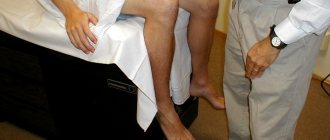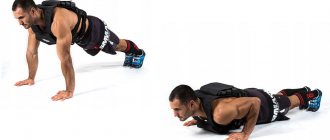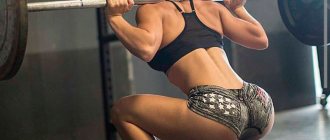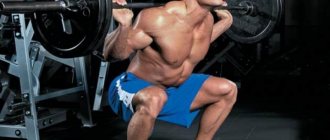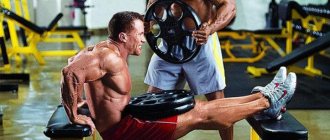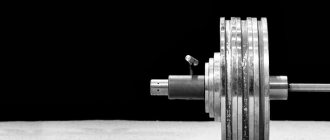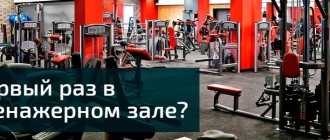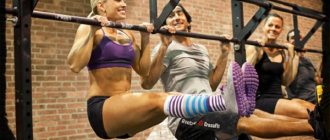Here is the third thematic article in which I will give a number of important tips for effective leg development. Kind of like the icing on the cake, but before you eat it, try the main dish:
- How guys can pump up their calves for summer, and girls - buttocks
- 5 Essential Exercises to Develop Epic Legs
The principle of high-repetition training in bodybuilding
The essence of the technique is to perform multi-repetition exercises. Technology, foundations, rules and other factors usually do not change. The basis of the system is to maintain a long load time due to the duration of the sets. It leads to:
- Increased but still moderate muscle acidification, which affects hypertrophy;
- Stimulation of mechanical and other growth factors;
- Allows you to achieve the same growth of muscle tissue (sometimes even more, in comparison with “low repetitions”), working with lighter weights;
- Less trauma and stress on joints.
A common problem among even advanced level athletes is the classification of the multi-repetition training principle. The technique is a high volume type where 20 to 30 repetitions are performed in each set. Athletes often mistakenly consider training programs that are performed 12-15 times per set to be multi-repetition. However, this type does not correspond to the technique of performing multiple repetitions of exercises.
One of the main controversies surrounding the training method was that it was not suitable for straight men, since this type was used mainly by professional athletes with an abundance of pharmacology and illegal drugs. This is partly a true statement if we are talking about the same unusually inflated training volumes. However, if you use the right amount of load, such a system becomes incredibly effective even for beginners. It is also extremely important to understand that the more movements an athlete needs to perform in one set (until complete or partial muscle failure), the lower his working weight will be.
Burning in the muscles
In addition, most people do this multi-repetition to cause a burning sensation in the muscles, because... This very majority is confident that burning is a sign of successful growth and productivity of training, and therefore tries to bring the muscles to this state at every training session.
The burning sensation is caused by lactic acid , a byproduct of glycogen metabolism in muscle tissue that has nothing to do with muscle growth and is a consequence of performing high repetitions. The more repetitions you perform, the more acid accumulates in the working muscle. They are especially often achieved during pumping .
The most common mistake that constantly occurs in gyms is that people try to insert a “burning” set into every workout. You should use this as shock therapy and not on a permanent basis.
Is it possible to pump up with high repetitions?
If we are talking about muscle hypertrophy, then you can pump up using high-repetition techniques in the same way as using other types of training. Some muscle groups can respond even more effectively to high repetitions. This is especially true for the shoulders, arms, and calves. Moreover, some athletes respond especially well to such training, which often becomes the main way out of stagnation or plateau.
When working on mass, it is important to monitor the total volume and prevent excessive muscle acidification.
Splits and full body workouts
There has long been a debate about which is better: a full body workout (fullbody) or a body workout for individual muscle groups (split). Let's figure it out.
- Fullbadi
- Splits
Fullbody is a system of training all muscle groups (whole body) in one workout. Using this method, we can work out all muscle groups up to 2-3 times a week, which allows us to create more favorable conditions for their growth and tone.
It would seem, well, great! BUT : due to the fact that we train 3 times a week and during this time we train all muscle groups at once, it is easy to calculate that each of them trains three times a week, which is why we do not have time to recover, and the total accumulates physical fatigue. Imagine the load that will accumulate in your body over a week, which will inevitably cause either breakdown and gluttony, or psychological and emotional weakness.
Fructose: is it possible to eat fruit and lose weight?
Split is a training system in which the load in a weekly cycle is divided between different muscle groups. Thanks to this, we can train them harder, more volume, but less often.
So, we break the whole body into separate muscle groups. Because of this, the load on a muscle group occurs only once in a weekly cycle. As a result, we give the muscles more time to rest and although our level of development is slightly less than in the case of a fullbody, the level of general physical fatigue is also less. In short: to each his own.
10 Coolest Butt Workouts: Opinion from Fitness Experts
Example of a split program: (the names are arbitrary so that you understand the difference in muscle groups)
Day 1: butt, legs and chest Day 2: back and shoulders Day 3: hamstrings, biceps, triceps
Muscle growth (and therefore weight loss with appropriate nutrition) will occur both with fullbadi and with the split system. What to choose?
Everything is simple and logical. From the beginning of visiting the gym, we can train in fullbadi, and when our level of development reaches its maximum, we will simply switch to split programs. Why are we doing this? In this case, we first allow the body to develop as much as possible in a shorter period of time than when using a split system. And later, when we reach a certain muscle tone, we switch to split training, as this will allow us, albeit a little slower, to develop further, without fear of developing enormous fatigue. It is also effective to combine fullbadi and splits. You can practice this training:
Day 1 – legs + butt Day 2 – arms + back Day 3 – full body.
It all depends on you and the condition of your body. Now it all seems complicated and confusing to you, but when you start practicing, you will understand that the body itself tells you which system is right for you personally. Try, try and try again - the path to a healthy, beautiful body is tortuous, because it is IMPOSSIBLE to create a technique that suits EVERYONE . Don’t be afraid of mistakes, the main thing is to find a comfortable, effective training system for you personally and move towards success.
Advantages and disadvantages
Advantages:
- Working with lighter weights, there is less risk of injury;
- Less stress on joints;
- You can train at home, where there is no opportunity to install equipment (you can do multiple repetitions with dumbbells);
- Increased calorie expenditure, which leads to slightly greater fat loss and better muscle definition;
- The safest type of training after 40 years, which helps maintain weight without undue stress on cartilage tissue. It also does not enhance degradation processes.
There are only two pronounced disadvantages to the multi-repetition system:
- Less strength development compared to other methods;
- Increased likelihood of overtraining with insufficient control of training volumes.
It has been proven that such training is less effective in developing strength. They develop strength endurance much better. Therefore, it is used mainly for gaining weight. If we are talking about increasing strength, high repetitions can only be relevant during the period of recovery from injuries, when it is necessary to temporarily reduce the weights used.
Don't neglect basic exercises
At first glance, it seems that the legs are very simple in their structure: the front surface of the thigh (quadriceps), the back surface of the thigh (biceps), buttocks and calf muscles. In reality, these are dozens of muscles, including not only pushers and pullers, but also stabilizers.
If you try to make it easier on yourself and train the largest muscle group in the body with simple isolation exercises like leg extensions or leg curls, you won't work even a third of them. Additionally, there will be no famous anabolic response that jumpstarts the development of the entire body.
The higher the stress, the greater the hormonal response. The more muscles involved in work at the same time, the higher the stress will be.
During the mentioned leg extensions in the simulator, you load only the quadriceps, and then only partially. During squats with a barbell on the shoulders, the quadriceps, buttocks, sartorius muscles, inner thigh, hamstring, plus core muscles (abs, obliques, extensors) are significantly loaded.
Even the platform press does not load the legs as much as squats with weights, although this exercise can also be classified as basic. Or, at a minimum, to the basic movements for building powerful lower limbs.
Do not forget about the technique of performing the exercise - the squat must be done as deep as possible (as far as flexibility allows), and the knees should not go beyond the line of the toes. Otherwise, there will be excessive stress on the knee joint, which will lead to premature wear.
By the way, the practice of placing thin pancakes under your heels “pushes” your knees forward very much - don’t do this. If you fall back, work on your flexibility, place your feet a little wider, spread your toes 45°, move your pelvis back more, lean forward a little more, and so on. Choose the movement for yourself, and it is advisable to do this under the supervision of an experienced trainer. There are no identical squats, because each of us has different levers, that is, the length of the thigh and lower leg, and the places where the muscles are attached differ.
Squat to at least parallel to the floor (90° angle between thigh and shin) to engage the hamstrings, glutes, and stabilize the knee joint. One of the best articles on squat technique is here.
In addition, the fundamental movements for developing legs include the Romanian deadlift :
And deadlift , be it classic or sumo:
Hack squats work the leg muscles well, but I don’t recommend using them until you learn how to squat normally with a barbell. The same applies to working in a Smith machine, in which it is very easy for a beginner to get injured. I talked more about dangerous strength exercises in a feature article.
Which is better, high reps or low reps in bodybuilding?
Each system, type of training and technique bears fruit, like any physical activity. However, taking into account the individuality of athletes (different ratios of fast and slow fibers, anthropometry and other factors), it is impossible to predict the result in advance.
Therefore, the most optimal approach for muscle growth is alternating different types of training. This allows you not only to avoid muscular adaptation and “getting used to” loads, but also to find out what type of body an athlete responds to most effectively. If you evaluate the training of advanced athletes and professionals, you can increasingly see a tendency towards high-repetition sets.
Healthy knee joints are the key to healthy legs
I don’t think it’s worth reminding once again about the correct technique for doing the exercises - it goes without saying. But besides this, you cannot neglect the development of certain muscles or hope that only basic movements will solve all problems. In particular, if you focus on developing your quadriceps and neglect to work on your hamstrings, your knees will suffer. After all, both muscle groups mentioned are antagonists in relation to the knee joint.
Ideally, the quadriceps should be stronger in a 3:2 ratio. That is, if you extend your legs 10 times in a machine with a weight of 60 kg, then you should bend them the same number of times with a weight of 40 kg. If the proportion suffers in favor of the front surface of the thigh, immediately correct this discrepancy.
Yes, the hamstrings do work during squats, but only partially. It is much better loaded when bending the legs in any position, be it lying down or standing - this is work from the knee joint.
the hip joint , makes a big contribution . The latter is one of the best exercises for developing the buttocks and upper hamstrings.
How to alternate between high and low repetitions
There are two most optimal, proven and effective ways of alternating two styles of training:
- According to microcycles - a week of strength (low-repetition) style, the next week - high-repetition style;
- By cycle - change the system and type of training every 8-10 weeks.
In the first case, you can avoid muscle adaptation over a long period of time by simply changing training styles (as well as the order of exercises, technique, etc.) from week to week. In the second case, the distinct advantage will be the ability to track the progress of an entire block, ultimately choosing those loads that give the maximum response.
Low reps + high weight. Strength Development
A small number of repetitions in one set with a large weight develops strength. The results of a study published in the Journal of Strength and Conditioning Research show:
If you want to build strength, your method is low reps + high weight.
Another study of the strength training of weightlifters showed that not only our muscles, but also the central nervous system, that is, muscle memory, are responsible for the ability to lift weights. Trainer Greg Nuckols believes that lower reps combined with heavier weights help our nervous system remember how to most effectively use muscles to lift weights.
If you're using your maximum weight or 90% of it, do one to three reps per set. Reducing the weight allows you to increase the number of repetitions: at 50-60% of the maximum weight, it is recommended to do up to 10-12 repetitions.
Pauses between approaches should be from two to six minutes to restore reserves. The optimal number of repetitions in one approach is from six to 12.
What's the best way to train? Research results
At the end of the eight-week cycle, both groups received the same increase in muscle mass (biceps, triceps, quadriceps). Apparently, for the growth of muscle mass, it does not matter whether the exercises are performed with relatively heavy or light weights.
1-rep max in the bench press and squat increased more in the group that trained with heavier weights. The increase in bench press 1RM in the low-intensity group was not even statistically significant.
But by the end of the experiment, the low-intensity group was able to perform significantly more reps on the bench press at 50% of their 1RM. The graph above shows that the total number of kilograms that subjects in the high-intensity group were able to perform to failure at 50% of their 1RM actually decreased, but not significantly.

